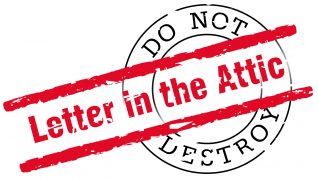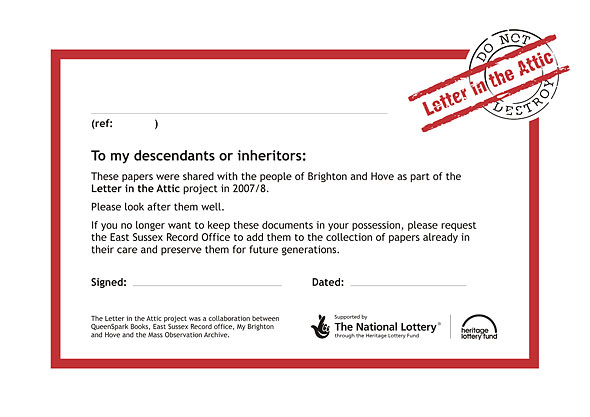
Letter in the Attic logo
Letter in the Attic is a collection of over 780 letters and diaries and other personal papers related to Brighton and Hove. The papers were collected through an appeal to the general public in 2007-8. Here are some of the lessons we learnt from running the project.
The great unknown: starved or swamped?
When we started the Letter in the Attic project, we had no idea whether we would be swamped with letters and diaries from the general public, or starved of contributions. There didn’t appear to be a similar project that could yield any clues, so we spent the first three months of the project running a pilot to find out.
The answer is that these documents are much more difficult to collect than, say, photos, postcards or even non-personal documents such as household bills and invoices. The local record office (East Sussex Record Office) ended up being delighted with the range and quality and quantity of what we collected, but it was hard work.
Why is it hard to collect letters and diaries?
This was for a number of reasons:
- Letters and diaries related to an area (in our case Brighton and Hove) don’t end up in the locality. We had a lot of offers of documents related to other parts of the country.
- Often potential contributors felt the documents in their possession were too everyday or mundane, and so didn’t bring them forward.
- These types of personal documents are indeed personal, so particularly in the case of contemporary material by individuals who were still alive, they were not offered. We treasure a set of very private diaries written in 2004, and they will undoubtedly be of historical significance (they have a very different quality from blogs, which are written to be public in the first place)
- The documents are in the attic! So it does actually take a bit of time and work – even if the contributor is potentially willing – to find them and make them available. We lost a few contributions along the way as busy lives took precedence.
- There are copyright issues. The owner of the letter is the person who receives it, but the copyright belongs to the person who writes it.
Originals or copies?
Our pilot established that 3 out of 4 potential contributors were not willing to part with the original documents, though they were very happy to share copies.
We therefore had to scan much more material than we had anticipated – and of course we could only scan a sample of some of the longer documents that contributors wished to retain. The benefit of this was that our online catalogue is much richer than it would be otherwise, because we already had a digitised collection to share with the world.
Donor cards
We gave ‘donor cards’ to the contributors who wished to keep the original documents. The donor card was a certificate, to be kept with the papers. The certificate confirmed that a copy of the document had been contributed to Letter in the Attic and that – if in future a family member no longer wished to take care of the original – they should contact the East Sussex Record Office.

Donor certificate for Letter in the Attic
Publicity and the personal approach
We had a lot of interest from the media in the project. We were featured on local BBC TV news; had a double-page spread in the main local paper (the Argus) and an extended guest slot on local radio (BBC Southern Counties); and we were featured in the magazine that is distributed on all of Brighton’s busses! We also had articles in numerous neighbourhood and community magazines.
The most successful approach in terms of gaining contributions, however, was face-to-face contact – perhaps the personal approach worked best because the letters and diaries we are collecting are such personal documents. We attended community events and street festivals, and gave talks to local groups – and our Open Day at Brighton Library in June 2008 was packed solid.
The volunteer team
We found that the team who very ably assisted with the project ended up specialising in particular tasks. We had originally envisaged that particular contributions would be assigned to particular contributors, who would then carry through the whole process of cataloguing (and if necessary, digitising) the material. Instead, the volunteer team ended up showing aptitudes and interests in particular parts of the process. So there was one individual who helped with scanning and photography; one who specialised in cataloguing; one who liaised with the contributors; others who transcribed material, and so forth.
Cataloguing for non-archivists
The cataloguing was carried out by the volunteer and project team, and was then checked by Andrew Bennett, the archivist at East Sussex Record Office. This process was made much easier by the online cataloguing software developed for the project by Ian Grant (now available through www.communitysites.co.uk). The software made the cataloguing extremely easy to use for non-archivists (no unfamiliar terms like ‘fonds’ or ‘sub-fonds’), yet ensured that the catalogue was complaint with the international cataloguing standards (ISAD(G)), and could be exported to the East Sussex Record Office, and then on to the National Archive database, at the click of a button.
An interesting point was that contributors were quite willing in some cases to help with cataloguing, if supplied with the appropriate forms and guidance. Many of them had already transcribed some of the letters and diaries in their possession.
Education packs
The project is producing an education pack based on the material with the help of a local school, Cardinal Newman, who have played a leading role in designing and piloting the material. The education side of the project was steered by an advisory group of local education professionals. The pack will be publicised at a local inset day in April 2009, when a presentation will be made to a gathering of all the local history teachers in the area.
Any questions?
If you’re interested in finding out more about the running of the Letter in the Attic project, contact Jack Latimer on jack@letterintheattic.org .




No Comments
Add a comment about this page